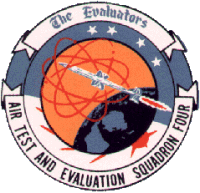
|
VX-4 Evaluators 1950 - 30 September 1994
1950 - 30 September 1994
Air Development Squadron FOUR, redesignated Air Test and Evaluation Squadron FOUR on 1 January 1969, was originally commisioned in 1950 in New England, principally for the development of airborne early warning systems. The squadron was moved to NAS Patuxent River in 1951 where it was disestablished later that year due to the lapse of assigned projects. VX-4 was recommissioned in 1952 at NAS Point Mugu to conduct evaluations of air-launched guided missiles as assigned by the Commander, Operational Test and Evaluation Force. In 1960 the squadron began to include additional project tasks not directly associated with guided missiles. Projects such as the operational test and terrain clearance radar, Doppler navigation systems, and air-to-air distance measuring equipment were included in the squadron's tasks. The aircraft assigned to VX-4 are characteristic of thos in current Fleet use or which will shortly be in use. Initially, the squadron was equipped with hte Chance Vought F7U Cutlass. Later, the McDonnell Douglas F3D, redesignated F-10, the two-seat Skynight, was added to the inventory. With the advent of the Bullpup and SParrow III missiles, the North American FJ Fury, Douglas A-4 Skyhawk, and the McDonnell Douglas F3H Demon replaced the Cutlass and the Skynight. The Sidewinder, a heat seaking missile, brought the Ling-Temco-Vought F-8 Crusader to VX-4. The McDonnell Douglas F-4 Phantom II was introduced to VX-4 in the early 1960's. The F-14A Tomcat arrived in the '70s and recently VX-4 has added the F/A-18 and newer F-14 variants. Latest operational test and evaluation of airborne fighter weapons systems included AIM-7M Sparrow, AIM-9M Sidewinder, and AIM-54C Phoenix missiles, radar warning devices, and self-protection jammers. January 1990 marked the end of the F-4 Phantom's nearly 3 decades of service with VX-4. A few months later, the newest addition to VX-4, hte F-14D Super Tomcat, arrived to enter OpEval. Beginning in 1990, the squadron supervised OpEval of the T-45 Goshawk in the first operational test of a complete aircraft training system. Throughout the year VX-4 tested and developed tactics for hte ALR-67 radar warning receiver and contributed to the system's incorporation in the F-14B/B. VX-4 also began developing tactics for employment of the new AIM-120 AMRAAM. After Iraq's invasion of Kuwait in August 1990 and throughout 1991, VX-4 was instrumental in the identification of deficiencies, testing and dielding of fixes to fighter weapons systems during Desert Shield, Desert Storm and subsequent operations in Southwest Asia. After Desert Storm commenced in January 1991, VX-4 continued to funnel the latest information to the fleet via mesages and briefings presented by VX-4 aircrews deployed aboard carriers in the REd Sea and northern Arabian Sea. After Desert Storm, the tempo at VX-4 returned to a more normal pace. AMRAAM testing aboard F/A-18, which began in January 1991, continued throughout the year. OpEval of the F-14D, begun in 1990, likewise continued. Other 1991 projects included tsting the Swedish BOL chaff dispenser on the F-14, various Sidewinder, Sparrow and Phoenix missile evaluations and infrared search and track set tests on the F-14D. ALR-67 (ECP-510) testing in the F/A-18 was one of the squadron's more significant projects in late 1991 and 1992. AMRAAM testing was finally completed in early 1994. By late 1993, Hornet testing was winding down at VX-4 and preparations were underway for the transfer of all F/A-18 projects and F/A-18C/D aircraft to VX-5 at China Lake as an initial step in the consolidation of the two squadrons. The first Hornet departed for China Lake before the end of 1993, with the remainder of the squadron's aircraft following in early 1994. On 30 September 1994, VX-4 was disestablished and its asstes were reassigned to VX-9 (Detachment Point Mugu) Vampires. F-14A, early 1980s  F-14A, mid 1980s  F-14D  F-14D, 1994  |
Top of the page |
F-14 Tomcat Squadrons: VF-74 | VF-84 | VF-101 | VF-102 | VF-103 | VF-111 | VF-114 | VF-124 | VF-142 | VF-143 | VF-154 VF-191 | VF-194 | VF-201 | VF-202 | VF-211 | VF-213 | VF-301 | VF-302 | VF-1285 | VF-1485 VF-1486 | VX-4 | VX-9 | NAWC | NATC | NFWS | NASA | Iranian Air Force Carrier Airwings | Squadron Awards F-14 Tomcat: Other Topics: Start Page Foreword FAQ Updates Copyright © by Torsten Anft |